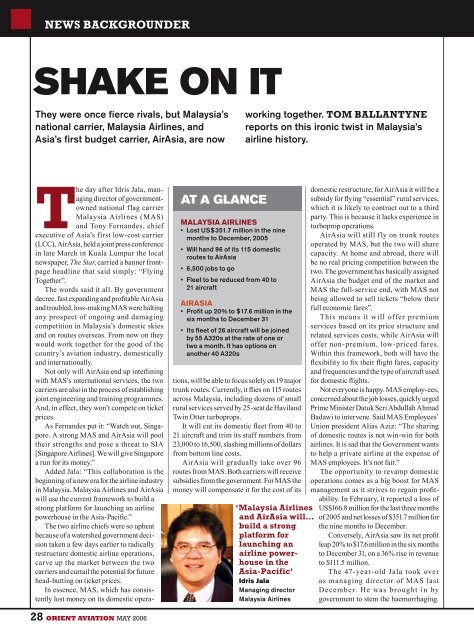Create successful ePaper yourself
Turn your PDF publications into a flip-book with our unique Google optimized e-Paper software.
NEWS BACKGROUNDERSHAKE ON ITThey were once fierce rivals, but Malaysia’snational carrier, Malaysia <strong>Air</strong>lines, andAsia’s first budget carrier, <strong>Air</strong>Asia, are nowworking together. TOM BALLANTYNEreports on this ironic twist in Malaysia’sairline history.The day after Idris Jala, managingdirector of governmentownednational flag carrierMalaysia <strong>Air</strong>lines (MAS)and Tony Fernandes, chiefexecutive of Asia’s first low-cost carrier(LCC), <strong>Air</strong>Asia, held a joint press conferencein late March in Kuala Lumpur the localnewspaper, The Star, carried a banner frontpageheadline that said simply: “FlyingTogether”.The words said it all. By governmentdecree, fast expanding and profitable <strong>Air</strong>Asiaand troubled, loss-making MAS were haltingany prospect of ongoing and damagingcompetition in Malaysia’s domestic skiesand on routes overseas. From now on theywould work together for the good of thecountry’s aviation industry, domesticallyand internationally.Not only will <strong>Air</strong>Asia end up interliningwith MAS’s international services, the twocarriers are also in the process of establishingjoint engineering and training programmes.And, in effect, they won’t compete on ticketprices.As Fernandes put it: “Watch out, Singapore.A strong MAS and <strong>Air</strong>Asia will pooltheir strengths and pose a threat to SIA[Singapore <strong>Air</strong>lines]. We will give Singaporea run for its money.”Added Jala: “This collaboration is thebeginning of a new era for the airline industryin Malaysia. Malaysia <strong>Air</strong>lines and <strong>Air</strong>Asiawill use the current framework to build astrong platform for launching an airlinepowerhouse in the Asia-Pacific.”The two airline chiefs were so upbeatbecause of a watershed government decisiontaken a few days earlier to radicallyrestructure domestic airline operations,carve up the market between the twocarriers and curtail the potential for futurehead-butting on ticket prices.In essence, MAS, which has consistentlylost money on its domestic opera-AT A GLANCEMALAYSIA AIRLINES• Lost US$351.7 million in the ninemonths to December, 2005• Will hand 96 of its 115 domesticroutes to <strong>Air</strong>Asia• 6,500 jobs to go• Fleet to be reduced from 40 to21 aircraftAIRASIA• Profit up 20% to $17.6 million in thesix months to December 31• Its fleet of 26 aircraft will be joinedby 55 A320s at the rate of one ortwo a month. It has options onanother 40 A320stions, will be able to focus solely on 19 majortrunk routes. Currently, it flies on 115 routesacross Malaysia, including dozens of smallrural services served by 25-seat de HavilandTwin Otter turboprops.It will cut its domestic fleet from 40 to21 aircraft and trim its staff numbers from23,000 to 16,500, slashing millions of dollarsfrom bottom line costs.<strong>Air</strong>Asia will gradually take over 96routes from MAS. Both carriers will receivesubsidies from the government. For MAS themoney will compensate it for the cost of its‘Malaysia <strong>Air</strong>linesand <strong>Air</strong>Asia will...build a strongplatform forlaunching anairline powerhousein theAsia-Pacific’Idris JalaManaging directorMalaysia <strong>Air</strong>linesdomestic restructure, for <strong>Air</strong>Asia it will be asubsidy for flying “essential” rural services,which it is likely to contract out to a thirdparty. This is because it lacks experience inturboprop operations.<strong>Air</strong>Asia will still fly on trunk routesoperated by MAS, but the two will sharecapacity. At home and abroad, there willbe no real pricing competition between thetwo. The government has basically assigned<strong>Air</strong>Asia the budget end of the market andMAS the full-service end, with MAS notbeing allowed to sell tickets “below theirfull economic fares”.This means it will offer premiumservices based on its price structure andrelated services costs, while <strong>Air</strong>Asia willoffer non-premium, low-priced fares.Within this framework, both will have theflexibility to fix their flight fares, capacityand frequencies and the type of aircraft usedfor domestic flights.Not everyone is happy. MAS employ-ees,concerned about the job losses, quickly urgedPrime Minister Datuk Seri Abdullah AhmadBadawi to intervene. Said MAS Employees’Union president Alias Aziz: “The sharingof domestic routes is not win-win for bothairlines. It is sad that the Government wantsto help a private airline at the expense ofMAS employees. It’s not fair.”The opportunity to revamp domesticoperations comes as a big boost for MASmanagement as it strives to regain profitability.In February, it reported a loss ofUS$166.8 million for the last three monthsof 2005 and net losses of $351.7 million forthe nine months to December.Conversely, <strong>Air</strong>Asia saw its net profitleap 20% to $17.6 million in the six monthsto December 31, on a 36% rise in revenueto $111.5 million.The 47-year- old Jala took overas managing director of MAS lastDecember. He was brought in bygovernment to stem the haemorrhaging.28 ORIENT AVIATION MAY 2006







![OAMag-V7N4-Cover [Converted] - Orient Aviation](https://img.yumpu.com/48598575/1/190x255/oamag-v7n4-cover-converted-orient-aviation.jpg?quality=85)








